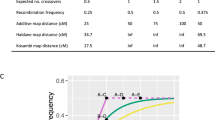Abstract
A maximum-likelihood approach is used in order to estimate recombination fractions between markers showing segregation distortion in backcross populations. It is assumed that the distortions are induced by viability differences between gametes or zygotes due to one or more selected genes. We show that Bailey's (1949) estimate stays consistent and efficient under more general assumptions than those defined by its author. This estimate should therefore be used instead of the classical maximum-likelihood estimate. The question of detection of linkage is also discussed. We show that the order of markers on linkage groups may be affected by segregation distortion.
Similar content being viewed by others
References
Bailey NTJ (1949) The estimation of linkage with differential viability, II and III. Heredity 3:220–228
Bailey NTJ (1951) Testing the solubility of maximum likelihood equations in the routine application of scoring methods. Biometrics 7:268–274
Edwards AWF (1972) Likelihood. The John Hopkins University Press, Baltimore
Garcia-Dorado A, Gallego A (1992) On the use of the classical tests for detecting linkage. J. Hered 83:143–146
Lander ES, Green P (1987) Construction of multilocus genetic linkage maps in humans. Proc Natl Acad Sci USA 84:2363–2367
Lathrop GM, Lalouel J-M (1988) Efficient computations in multilocus linkage analysis. Am J Hum Genet 42:498–505
Lyttle TW (1991) Segregation distorters. Annu Rev Genet 25:511–557
Mather K (1957) The measurement of linkage in heredity. Methuen and Co., London
Neumann PE (1990) Two-locus linkage analysis using recombinant inbred strains and Bayes' theorem. Genetics 126:277–284
Ott J (1985) Analysis of human genetic linkage. John Hopkins Press, Baltimore
Schön CG, Hayes PM, Blake TK, Knapp SJ (1991) Gametophytic selection in a winter x spring barley cross. Genome 34:918–922
Torres AM, Mau-Lastovicka T, Williams TE, Soost RK (1985) Segregation distortion and linkage of Citrus and Poncirus isozyme genes. J Hered 76:289–294
Wendel JF, Parks CR (1984) Distorted segregation and linkage of alcohol dehydrogenase ec-1.1.1.1 genes in camellia-japonica theaceae. Biochem Genet 22:739–748
Zivy M, Devaux P, Blaisonneaux J, Jean R, Thiellement H (1992) Segregation distortion and linkage studies in microspore-derived double haploid lines of Hordeum vulgare L. Theor Appl Genet 83:919–924
Author information
Authors and Affiliations
Additional information
Communicated by G. Wenzel
Rights and permissions
About this article
Cite this article
Lorieux, M., Goffinet, B., Perrier, X. et al. Maximum-likelihood models for mapping genetic markers showing segregation distortion. 1. Backcross populations. Theoret. Appl. Genetics 90, 73–80 (1995). https://doi.org/10.1007/BF00220998
Received:
Accepted:
Issue Date:
DOI: https://doi.org/10.1007/BF00220998




